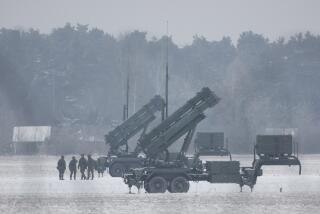Chemical Warfare Gear Lost, Audit Finds
- Share via
WASHINGTON — The Pentagon has lost track of up to 250,000 defective chemical warfare suits, a congressional audit found Tuesday, prompting concerns among lawmakers that the military was playing “Russian roulette” with the lives of American soldiers who face the prospect of chemical or biological warfare in Iraq.
A report by the General Accounting Office found that the Defense Department has shown improvements since a spate of problems during the Persian Gulf War in preparing for chemical and biological attacks.
But the report said the military has persistent problems in training and equipping soldiers and keeping track of equipment such as the protective chemical suits.
As a result, the report concluded, the “risk for protective-clothing shortages may increase dramatically from now through at least 2007.”
Defense officials countered that many of the suits might have been used and discarded. Even if the suits still exist, front-line soldiers would be unlikely to wear them because most have been given more modern suits.
The report drew criticism from members of the House Government Reform subcommittee at a hearing on national security, where it was released. If the U.S. wages war on Iraq, said Rep. Christopher Shays (R-Conn.), panel chairman, “it must be assumed those men and women will face chemical and biological weapons,” a situation that could leave them playing “Russian roulette” with faulty suits.
Some House members who have voiced opposition to attacking Iraq questioned whether they should approve a resolution giving the Bush administration authority to wage war against Iraq while such problems persist. “I’m not going to support going blindly into warfare that could result in great bodily harm to our fighting men and women,” said Rep. Diane Watson (D-Los Angeles).
The defective suits were among 800,000 recalled in 2000 after investigators found that Istratex, a bankrupt New York company, had delivered them with holes, poor stitching and other problems that would allow chemical or biological agents to permeate them.
Defense officials have tracked down 550,000, but they haven’t found the rest. George Allen, head of the Defense Logistics Agency, said he believed the defective suits had been used and discarded, but their fate is unknown because of poor controls at military bases.
When Rep. Benjamin A. Gilman (R-N.Y.) asked if that means some military units have flawed suits, Allen said, “Sir, I cannot say for certain if there is or is not.”
The Pentagon has an estimated 4.5 million protective suits on hand. Of those, 1.5 million are new Joint Service Lightweight Integrated Suit Technology models, which are given to soldiers most likely to be among the front-line troops in Iraq or elsewhere.
But the tracking system for them remains inadequate, the GAO report found. At 293 sites visited by GAO investigators in the last three years, local commanders’ tracking systems for the new suits ranged from computer spreadsheets to chalkboard listings to, in some cases, no system at all. This follows a previous GAO report that found tracking so ineffective that some units were buying $200 protective suits while others were selling them on eBay for $3 apiece.
A 1996 audit found that troops deployed early in the Gulf War lacked required equipment such as protective clothing and decontamination kits. Soldiers and Marines were inadequately trained for chemical and biological warfare, and vaccine and immunization stocks were inadequate.
Major improvements have been made in preparing soldiers since then, Anna Johnson-Winegar, assistant Defense secretary for chemical and biological defense, told the House panel.
The report said that despite improvements, defense officials lacked a coherent strategy to address low-level exposure to chemical warfare agents.
The new audit found ongoing shortages of some protective equipment. One Air Force wing had only 25% of the masks deemed necessary to treat contaminated patients and half the kits required to decontaminate patients exposed to chemical or biological agents. Many Army and Marine units were lacking in the required number of chemical specialists.
More to Read
Sign up for Essential California
The most important California stories and recommendations in your inbox every morning.
You may occasionally receive promotional content from the Los Angeles Times.












